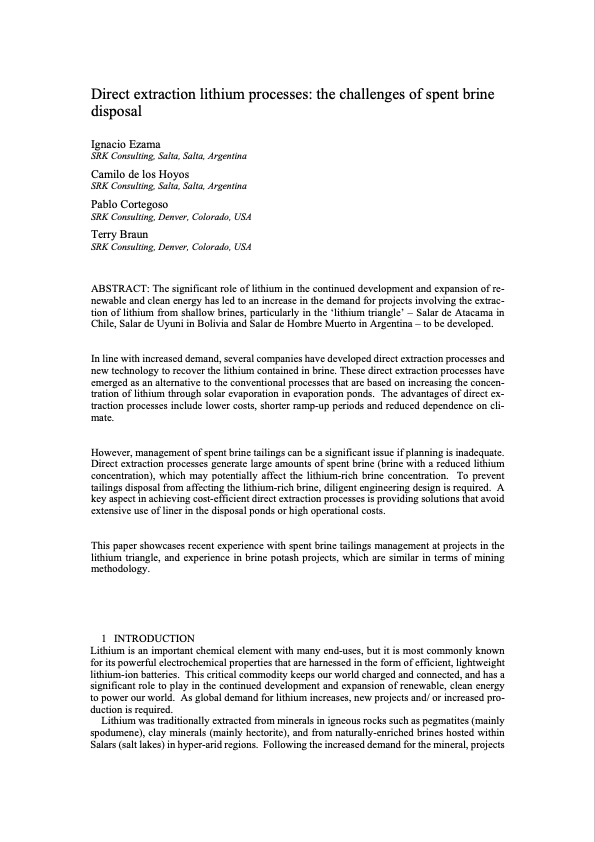
PDF Publication Title:
Text from PDF Page: 001
Direct extraction lithium processes: the challenges of spent brine disposal Ignacio Ezama SRK Consulting, Salta, Salta, Argentina Camilo de los Hoyos SRK Consulting, Salta, Salta, Argentina Pablo Cortegoso SRK Consulting, Denver, Colorado, USA Terry Braun SRK Consulting, Denver, Colorado, USA ABSTRACT: The significant role of lithium in the continued development and expansion of re- newable and clean energy has led to an increase in the demand for projects involving the extrac- tion of lithium from shallow brines, particularly in the ‘lithium triangle’ – Salar de Atacama in Chile, Salar de Uyuni in Bolivia and Salar de Hombre Muerto in Argentina – to be developed. In line with increased demand, several companies have developed direct extraction processes and new technology to recover the lithium contained in brine. These direct extraction processes have emerged as an alternative to the conventional processes that are based on increasing the concen- tration of lithium through solar evaporation in evaporation ponds. The advantages of direct ex- traction processes include lower costs, shorter ramp-up periods and reduced dependence on cli- mate. However, management of spent brine tailings can be a significant issue if planning is inadequate. Direct extraction processes generate large amounts of spent brine (brine with a reduced lithium concentration), which may potentially affect the lithium-rich brine concentration. To prevent tailings disposal from affecting the lithium-rich brine, diligent engineering design is required. A key aspect in achieving cost-efficient direct extraction processes is providing solutions that avoid extensive use of liner in the disposal ponds or high operational costs. This paper showcases recent experience with spent brine tailings management at projects in the lithium triangle, and experience in brine potash projects, which are similar in terms of mining methodology. 1 INTRODUCTION Lithium is an important chemical element with many end-uses, but it is most commonly known for its powerful electrochemical properties that are harnessed in the form of efficient, lightweight lithium-ion batteries. This critical commodity keeps our world charged and connected, and has a significant role to play in the continued development and expansion of renewable, clean energy to power our world. As global demand for lithium increases, new projects and/ or increased pro- duction is required. Lithium was traditionally extracted from minerals in igneous rocks such as pegmatites (mainly spodumene), clay minerals (mainly hectorite), and from naturally-enriched brines hosted within Salars (salt lakes) in hyper-arid regions. Following the increased demand for the mineral, projectsPDF Image | Direct extraction lithium processes

PDF Search Title:
Direct extraction lithium processesOriginal File Name Searched:
Ezama-Hoyos-Cortegoso-Braun-Spent_Brine_Disposal-TMW_Paper20191128190251287.pdfDIY PDF Search: Google It | Yahoo | Bing
Product and Development Focus for Infinity Turbine
ORC Waste Heat Turbine and ORC System Build Plans: All turbine plans are $10,000 each. This allows you to build a system and then consider licensing for production after you have completed and tested a unit.Redox Flow Battery Technology: With the advent of the new USA tax credits for producing and selling batteries ($35/kW) we are focussing on a simple flow battery using shipping containers as the modular electrolyte storage units with tax credits up to $140,000 per system. Our main focus is on the salt battery. This battery can be used for both thermal and electrical storage applications. We call it the Cogeneration Battery or Cogen Battery. One project is converting salt (brine) based water conditioners to simultaneously produce power. In addition, there are many opportunities to extract Lithium from brine (salt lakes, groundwater, and producer water).Salt water or brine are huge sources for lithium. Most of the worlds lithium is acquired from a brine source. It's even in seawater in a low concentration. Brine is also a byproduct of huge powerplants, which can now use that as an electrolyte and a huge flow battery (which allows storage at the source).We welcome any business and equipment inquiries, as well as licensing our turbines for manufacturing.| CONTACT TEL: 608-238-6001 Email: greg@infinityturbine.com | RSS | AMP |